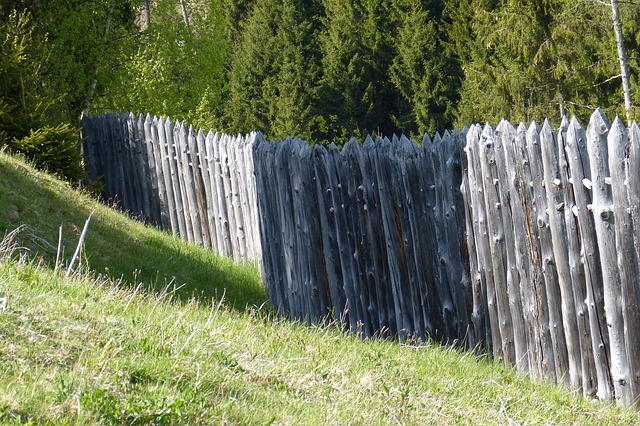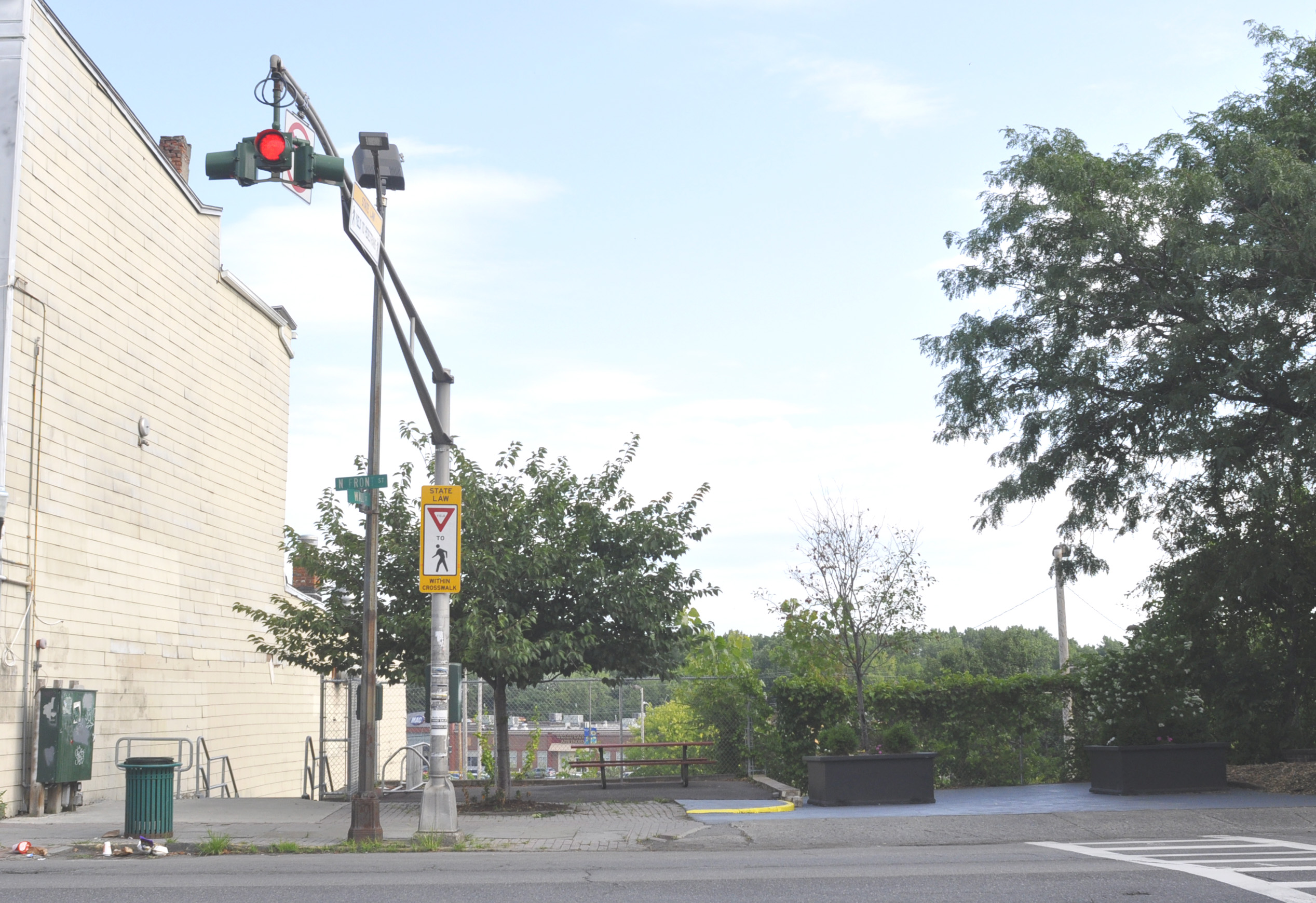DOCUMENTS, REPORTS, MAPS AND VISUALS
Perched on a bluff above the Esopus Creek, a tributary that winds through Kingston before emptying into the Hudson River further north, the Stockade District is home to the original Dutch settlement surrounded by wooden palisades meant to fend off Indian attacks, built by Peter Stuyvesant and completed by 1658. This is where the Kingstonian is to be built.

Palisade surrounding Celtic village
At stake are lots on either side of the Fair Street Extension — on the west side, formerly owned by the city of Kingston, and on the east, by Brad Jordan. On the north-south plane, the lots straddle the edge of the bluff where the early settlers pitched their palisades to protect from Indian raids, then down a steep drop to lowlands carved by glaciers in millennia gone by. The drop is sometimes as high as 27 feet, sometimes in a gentle grade, sometimes in a steep angle.

The photo above, facing south, looks up to the bluff from former marshland and captures most of the lots that would become the Kingstonian.
The contrast in geography and geology between the bluff and the lowlands has led to sharply differentiated use. The bluff, known as the Stockade District, is today a dense and thriving business district that still follows the streetscape laid out almost four centuries ago. With predominantly VIctorian, Federal-era and pre-Revolutionary architecture, this historically significant tourist magnet boasts the only intersection in the United States where stone houses stand on all four corners.
As for the lowlands, when the glaciers receded 12,000 years ago they left behind the Esopus tributary nestled within an expanse of marshland. In colonial times, from their posts atop the bluff and behind the stockade, the settlers scanned that marshland for Indian raiders. Today, that marshland is a vast expanse of shopping mall, complete with dozens of small businesses such as nail salons, dollar stores, eateries and a gym, and larger businesses of medical offices and a supermarket that once was part of a local chain until it was bought out by a Dutch-based Ahold Corporation. One of the developers, Brad Jordan, owns the mall and the eastern lot.
The western lot, once a Montgomery Ward department store and then owned by the city until it was gifted to the development in 2021, is disparaged by project supporters as a so-called building tooth gap where lonely trees sprout from mismatched squares of cracked pavement that sometimes double as a garbage can for passers-by. The stairs in the LH corner lead down to a 138-car municipal parking lot, also gifted to the development. The parklet is used for various events and contains a picnic table.

Facing north, once a Montgomery Ward department store
Below are the reports asked for in this resolution by the Planning Board at a special June 3, 2019, meeting. Note that the “Green Concepts” document is merely a letter outlining environmental attributes the developers might “consider” or “endeavor to facilitate” — in other words, empty words.
CULTURAL RESOURCES
WATER SEWER
TRAFFIC
GREEN CONCEPTS
DEMOLITION
VISUALS
HABITAT
OTHER DOCUMENTS
RFQ (Request for Qualifications)
MoU (Memorandum of Understanding)
Wright Assignment to Jordan
EAF (Environmental Assessment)
Noble Pre-announces PB Vote
MoA (Memorandum of Agreement)
KINGSTON COMPREHENSIVE PLAN
ZONING AND THE COMPREHENSIVE PLAN
IDA DOCS
Kingstonian Application Jan 2021
NDC First Study $3.4 million loss
NDC Second study $256k benefit
Camoin Study
“Internal” CGR Study
VIDEO RECORDINGS OF MEETINGS
October 23, 2018 Public Informational Meeting at the LGBTQ Center Part 1 and Part 2
July 8, 2020 presentation to the IDA and transcript
July
A look at outside experts opinions.
Here is a report by the Special Rapporteur to the Office of the High Commissioner of Human Rights at the United Nations. Once again, the problem is the financialization of something that should not be a financial instrument.
https://www.ohchr.org/EN/Issues/Housing/Pages/FinancializationHousing.aspx
This is from Australia, but it’s just as valid here. This is what happens. https://theconversation.com/the-hollow-promise-of-construction-led-jobs-and-growth-82317
Or consider this section, from Elizabeth Warren’s platform when she ran for president.
How Wall Street Hurts the Broader Economy
The purpose of the financial sector is to connect savers with borrowers as efficiently as possible and to spread risk. A growing financial sector can help the rest of the economy if it helps connect more people more efficiently and spreads risk more effectively. But, as several studies have shown, past a certain point, the growth of the financial sector undermines the rest of the economy by extracting money from it without producing any real value.
America is well past that point. For example, a recent study found that “when private credit grows to the point where it exceeds GDP, it becomes a drag on productivity growth.” Private credit in America has exploded past that benchmark — it’s been between 160% and 210% of GDP for the last twenty years. The study also found that “when the financial sector represents more than 3.5% of total employment, further increases in financial sector size tend to be detrimental to growth.” We’ve blown past that one, too — in 2016, the financial sector represented more than 5% of total employment.
Past these tipping points, the growth of the financial sector hurts the economy for a few reasons:
- It generates more of its profits from “non-interest income” — another word for fees that extract money from the rest of the economy.
- It tends to lead to over-investment in companies that are lower-productivity but have lots of collateral to lend against — like construction and property development — luring more businesspeople into those fields.
